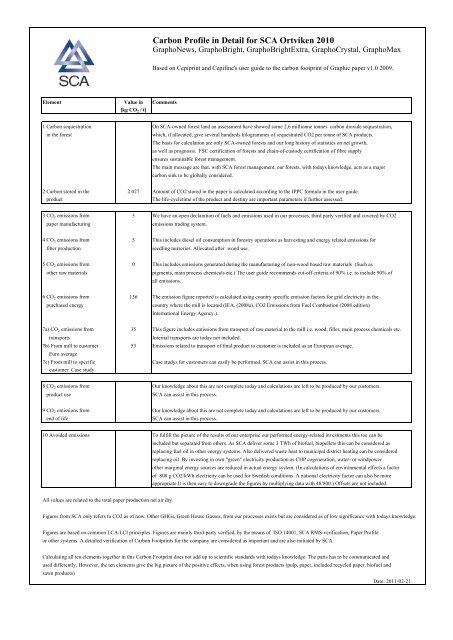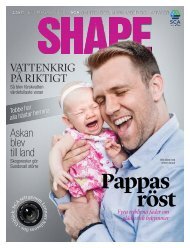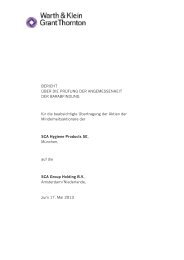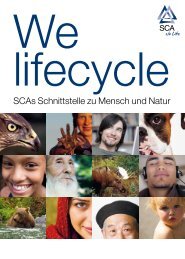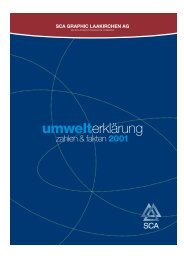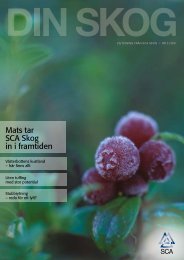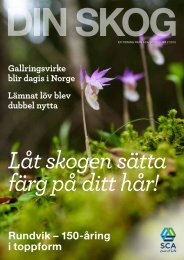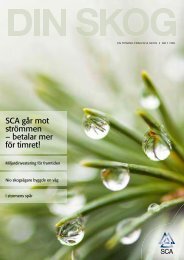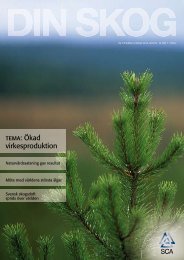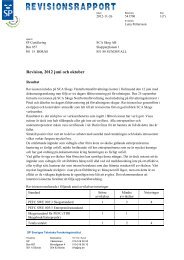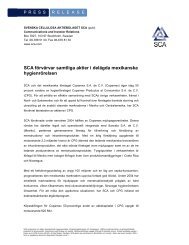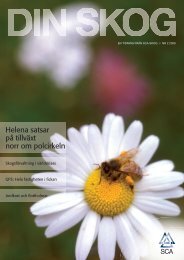SCA Graphic Paper Polska
SCA Graphic Paper Polska
SCA Graphic Paper Polska
Create successful ePaper yourself
Turn your PDF publications into a flip-book with our unique Google optimized e-Paper software.
Element Value in Comments<br />
[kg CO 2 / t]<br />
Carbon Profile in Detail for <strong>SCA</strong> Ortviken 2010<br />
GraphoNews, GraphoBright, GraphoBrightExtra, GraphoCrystal, GraphoMax<br />
Based on Cepiprint and Cepifine's user guide to the carbon footprint of <strong>Graphic</strong> paper v1.0 2009.<br />
1 Carbon sequestration On <strong>SCA</strong>-owned forest land an assessment have showed some 2,6 millionne tonnes carbon dioxide sequestration,<br />
in the forest which, if allocated, give several hundreds kilogrammes of sequestrated CO2 per tonne of <strong>SCA</strong> products.<br />
The basis for calculation are only <strong>SCA</strong>-owned forests and our long history of statistics on net growth,<br />
as well as prognosis. FSC certification of forests and chain-of-custody certification of fibre supply<br />
ensures sustainable forest management.<br />
The main message are that, with <strong>SCA</strong> forest management, our forests, with todays knowledge, acts as a major<br />
carbon sink to be globally considered.<br />
2 Carbon stored in the 2 027 Amount of CO2 stored in the paper is calculated according to the IPPC formula in the user guide.<br />
product The life-cycletime of the product and destiny are important parameters if further assessed.<br />
3 CO2 emissions from 5 We have an open declaration of fuels and emissions used in our processes, third party verified and covered by CO2<br />
paper manufacturing emissions trading system.<br />
4 CO2 emissions from 5 This includes diesel oil consumption in forestry operations as harvesting and energy related emissions for<br />
fiber production seedling nurseries. Allocated after wood use.<br />
5 CO2 emissions from 0 This includes emissions generated during the manufacturing of non-wood based raw materials (Such as<br />
other raw materials pigments, main process chemicals etc.) The user guide recommends cut-off criteria of 90% i.e. to include 90% of<br />
all emissions.<br />
6 CO2 emissions from 136 The emission figure reported is calculated using country specific emission factors for grid electricity in the<br />
purchased energy country where the mill is located (IEA. (2008a). CO2 Emissions from Fuel Combustion (2008 edition)<br />
International Energy Agency.).<br />
7a) CO2 emissions from 35 This figure includes emissions from transport of raw material to the mill i.e. wood, filler, main process chemicals etc.<br />
transports Internal transports are today not included.<br />
7b) From mill to customer<br />
Euro average<br />
53 Emissions related to transport of final product to customer is included as an European average.<br />
7c) From mill to specific<br />
customer. Case study<br />
Case studys for customers can easily be performed. <strong>SCA</strong> can assist in this process.<br />
8 CO 2 emissions from Our knowledge about this are not complete today and calculations are left to be produced by our customers.<br />
product use <strong>SCA</strong> can assist in this process.<br />
9 CO 2 emissions from Our knowledge about this are not complete today and calculations are left to be produced by our customers.<br />
end of life <strong>SCA</strong> can assist in this process.<br />
10 Avoided emissions To fulfill the picture of the results of our enterprise our performed energy-related investments this toe can be<br />
included but separated from others. As <strong>SCA</strong> deliver some 3 TWh of biofuel, biopellets this can be considered as<br />
replacing fuel oil in other energy systems. Also delivered waste heat to municipal district heating can be considered<br />
replacing oil. By investing in own "green" electricity production as CHP cogeneration, water- or windpower<br />
other marginal energy sources are reduced in actual energy system. (In calculations of environmental effects a factor<br />
of 800 g CO2/kWh electricity can be used for Swedish conditions. A national electricity factor can also be more<br />
appropriate.It is then easy to downgrade the figures by multiplying data with 48/800.) Offsets are not included.<br />
All values are related to the total paper production net air dry.<br />
Figures from <strong>SCA</strong> only refers to CO2 as of now. Other GHGs, Green House Gasses, from our processes exists but are considered as of low significance with todays knowledge.<br />
Figures are based on common LCA/LCI principles. Figures are mainly third-party verified, by the means of ISO 14001, <strong>SCA</strong> RMS-verification, <strong>Paper</strong> Profile<br />
or other systems. A detailed verification of Carbon Footprints for the company are considered as important and are also initiated by <strong>SCA</strong>.<br />
Calculating all ten elements together in this Carbon Footprint does not add up to scientific standards with todays knowledge. The parts has to be communicated and<br />
used differently. However, the ten elements give the big picture of the positive effects, when using forest products (pulp, paper, included recycled paper, biofuel and<br />
sawn products)<br />
Date: 2011-02-21


